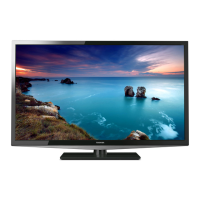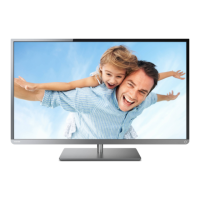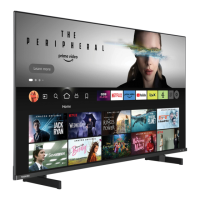
Do you have a question about the Toshiba 50L4300 Series and is the answer not in the manual?
Instructions on how to assemble the pedestal stand for your TV.
Crucial safety precautions for using the TV to prevent injury and damage.
Safety guidelines for installing outdoor aerials to avoid electrical hazards.
Instructions on when and how to contact service technicians for repairs.
Guidelines for cleaning the TV safely without damaging components.
Details on LCD screen care, afterimages, pixel issues, interference, and liability.
Steps and advice for connecting an aerial for optimal TV reception.
Instructions for inserting batteries into the remote control.
Overview of physical buttons on the TV and available input/output terminals.
Explanation of each button and its function on the TV remote control.
Step-by-step guide for initial TV setup, language, network, and channel tuning.
Detailed steps for manual channel tuning and position arrangement.
How to use the Signal Booster to improve picture quality with weak signals.
Instructions for naming or labeling video input sources.
Procedures for switching the TV on and understanding the power indicator.
How to display the TV's main home screen from broadcast or input.
Steps to start watching TV broadcasts or external inputs.
Overview of the menu structure, navigation, and adjustment controls.
Visual guide to the main menu categories: Picture, Sound, Applications, Preferences, Setup.
Accessing frequently used settings like Picture Mode and Media Player.
Guide to selecting country and changing channel positions.
Instructions for reordering or swapping TV channel positions.
Overview of picture controls and how to select various picture sizes.
Adjusting subtitle display for letterbox format broadcasts.
How to set the TV to display 14:9 aspect ratio broadcasts.
Setting to display images correctly without distortion or clipping.
Optimizing PC input display for correct image without distortion.
Setting PC input display to avoid picture clipping.
How to freeze and unfreeze the TV picture.
Personalizing picture style with preset modes like Dynamic, Standard, Movie.
Improving dark area definition by adjusting the Contrast Booster.
Enhancing motion and picture quality for movies with 24-frame content.
Customizing picture warmth or coolness by adjusting red, green, and blue tint.
Restoring colour temperature settings to factory defaults.
Reducing noise and blur for clearer pictures from compressed signals.
Restoring all picture settings to their original factory values.
Fine-tuning picture colour quality by adjusting base colours like Red, Green, Blue.
Restoring base colour adjustments to factory settings.
Automatically adjusts screen brightness for better visibility in dark scenes.
Guide to setting MTS, Dual/Mono modes, and stereo/bilingual programs.
Balancing sound levels for left and right speakers.
Choosing preferred sound modes like Dynamic, Natural, or Clear Voice.
Fine-tuning basic sound quality by adjusting Bass and Treble.
Enhancing audio for a fuller, richer, and wider sound experience.
Enhancing bass response for richer audio.
Restoring advanced sound settings to factory defaults.
Preventing audio distortion for clearer sound.
Optimizing sound based on whether the TV is wall-mounted or on a stand.
Controlling compression for Dolby Digital sound.
Reducing volume differences between channels or inputs.
Scheduling the TV to turn on automatically to a preset channel or input.
Scheduling the TV to turn off automatically after a set period.
Accessing and configuring Android system settings.
Automatically displays HDMI signal format irrespective of previous settings.
Muting sound and displaying a blue screen when no signal is received.
Switching 4:3 format programs to full screen.
Configuring the TV to automatically turn off when no signal is detected.
Checking the current software version installed on the TV.
Restoring all TV settings, including channels, to original factory values.
Choosing the input source for viewing content from external devices.
Configuring the colour system for standard video (composite) inputs.
Customizing labels for external input sources like DVD, Game, PC.
Viewing and managing the list of available TV channels.
Setting up Teletext language and mode (Auto/List).
How to use the TEXT button, sub-pages, and view main subjects.
Displaying subtitles when available on the teletext screen.
Viewing and changing favorite teletext pages.
Explanation of remote control buttons specific to teletext functions.
Diagram and explanation of rear connection ports for external devices.
Instructions for connecting HDMI and DVI devices to the TV.
Steps for connecting HDMI devices using an HDMI cable.
Instructions for connecting DVI devices using an HDMI-to-DVI adapter.
Choosing between PC or HDMI audio input for the PC/HDMI 1 terminal.
Selecting audio mode (Auto, Digital, Analogue) for HDMI 1 input.
Guide to connecting a PC via RGB/PC or HDMI terminals.
Optimizing picture clarity by adjusting the Sampling Clock.
Restoring PC settings to factory defaults.
Accessing and adjusting picture position and clock phase for PC input.
Using the Easy remote for TV operations like menu and volume.
Overview of the home screen layout, status bar, dock bar, and desktop areas.
Details on the TV window, channel display, and settings configuration.
Navigating between different desktop areas using the screen slide button.
Information displayed on the status bar, including notifications and time.
Viewing notification messages and related application or setup screens.
Accessing quick setup options from the detailed information screen.
How to perform searches using Google Search and interpret results.
Shortcut icons for frequently used applications found on the dock bar.
Accessing stored applications and widgets from the Drawer icon.
Procedure for logging out of the Android environment.
Important considerations for using Android features, including internet connection.
Accessing and navigating the YouTube homepage on the TV.
Steps to connect the TV to the internet using the browser.
Accessing and using the Google Play Store app for downloading applications.
Launching applications from the desktop or APPS screen.
Accessing the specific menu for individual applications.
Locating, moving, and removing application shortcut icons or widgets.
Removing downloaded applications or widgets from the TV.
Viewing tablet, smartphone, or PC screens on the TV.
Connecting the TV to a home network via LAN port.
Diagram and steps for establishing a wired network connection.
Connecting the TV wirelessly using a Dual Band WLAN Adaptor.
Instructions for operating the Dual Band Wireless LAN Adaptor.
Information on wireless interoperability, health, and restrictions.
Configuring the TV for wireless network connection using Easy Setup, Assisted, or Manual.
Managing network, data usage, sound, display, storage, apps, and users.
Adjusting volume, Audio Source Filtering, and other sound options.
Setting screen brightness, font size, and wallpaper.
Viewing storage capacity for items and available space.
Viewing preinstalled and downloaded applications.
Adding or deleting users and customizing profiles.
Setting and managing location information for the TV.
Configuring security options for the TV.
Configuring language, keyboard, and other input methods.
Configuring backup options and resetting the TV to factory defaults.
Checking Google account information and searching for locations.
Registering a new Google account on the TV.
Setting and adjusting the TV's date and time.
Configuring accessibility features for users with disabilities.
Disabling TV buttons to prevent accidental changes.
Setting the TV to automatically turn off after a specified time.
Configuring the TV to automatically turn off after inactivity.
Reducing power-on time by enabling Quick Start.
Checking information about the TV, including details of selected items.
Outputting TV broadcasts or external input images and audio.
Accessing and playing media files like photos, music, and videos.
Using TOSHIBA Service Station to update the TV system.
Using specific TV remote buttons to control Android features.
How to open and start the Media Player application.
Launching Media Player from the home screen icons.
Launching Media Player from the dock bar shortcut icon.
Procedures for closing the Media Player using TV remote or Easy remote.
Navigating and viewing photo files in Multi View, Single View, or Slide Show modes.
Watching photos as a slideshow with interval and repeat settings.
Selecting and playing video files from a list, with playback controls.
Playing DivX Plus HD files, including chapter navigation and rental file support.
Choosing preferred subtitle language and audio language for playback.
Configuring playback to repeat files once, repeatedly, or not at all.
Resuming video playback from the last stopped position.
Registering the TV to play DivX® Video-On Demand files.
Using the Easy remote control for media playback functions.
Listening to music files from a list view, with playback controls.
Configuring music playback repeat options (Off, All, 1).
Viewing file details like track number, artist, and album.
Exiting the Music Player application.
Lists supported file formats, media types, codecs, and notes for the Media Player.
Lists supported file formats, media types, codecs, and notes for the Media Player.
Lists RF frequencies for C mode and S mode channels.
Solutions for common TV problems like no picture, no sound, or remote issues.
Lists broadcast transmission systems (PAL, SECAM, NTSC) for different countries.
Technical details of the TV, including power, dimensions, weight, and inputs.
Lists included accessories for the 39L4300 and 50L4300 series TVs.
Specifies recommended temperature and humidity ranges for TV operation.
Information on trademarks and licenses for technologies used in the TV.
Legal agreement for the use of Toshiba and third-party software.
Restrictions on reverse engineering, decompiling, or disassembling the software.
Details on warranty terms, exclusions, and limitations of liability.
Ensures remaining provisions remain valid if any part of the EULA is found invalid.
Clarifies that waiving a breach does not waive future breaches.
Information on open source software licenses and terms.
Information on Wi-Fi location data and third-party application data collection.












